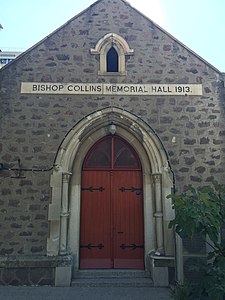St. John the Evangelist's Anglican Church, Izmir
| St. John the Evangelist Church, İzmir | |
|---|---|
 | |
 | |
| 38°26′13.4″N 27°08′50.2″E / 38.437056°N 27.147278°ECoordinates: 38°26′13.4″N 27°08′50.2″E / 38.437056°N 27.147278°E | |
| Country | Turkey |
| Denomination | Church of England |
| Churchmanship | Anglo-Catholic |
| Website | Official website |
| History | |
| Consecrated | 1899 |
| Architecture | |
| Functional status | Active |
| Architectural type | Church |
| Style | Gothic Revival |
| Administration | |
| Archdeaconry | Eastern Archdeaconry |
| Diocese | Gibraltar in Europe |
| Clergy | |
| Chaplain(s) | James Buxton |
The Anglican Church of St. John the Evangelist, also known simply as St. John's, is located in İzmir, Turkey, in the quarter of Alsancak.[1] It was built about 1625 by the Levant Company.
History[]
John mentions Smyrna, the modern İzmir, in Revelations 2:8-11 and one of his disciples, Polycarp, who is depicted in one of the stained glass windows of the church[2] became bishop of Smyrna. The church shares its name with the catholic cathedral of İzmir.
The church was built in 1898-1899.[3][4]
On 22 March 1911, William Collins, the Bishop of Gibraltar, died on board of the SS Saghalien en route from Constantinople to Smyrna and was subsequently buried in the church.[5]
The New Zealander Charles Dobson (1886-1930) was Chaplain of St. John's during the Great fire of Smyrna in 1922; he escaped the burning city with his wife and two small daughters and later became a key witness in the trial about the origins of the fire.[6] The Canadian Ronald Evans was Chaplain of St. John's for 15 years and retired on December 31, 2015.[3] His successor is James Buxton, formerly Dean of Chapel of Corpus Christi College, Cambridge, who was appointed as Chaplain of St. John’s İzmir and Mission to Seafarers Port Chaplain to İzmir on 18 September 2017.[7]
Architecture[]
The church was built in a neo-gothic architectural style. The architect of the church is unknown.

Exterior[]
The exterior design is also neo-gothic. On the west façade, there is a little rose window. Also on that façade there is a spire. Under the rose window, there are three stained-glass windows, behind iron barriers. On the north façade there are small flying buttresses.
Stained-Glass Windows[]
The back (west) window was made in Germany in 1895. The front (east) window was made in 1904 by Charles Kempe and includes a small panel showing Ignatius of Antioch on his way to martyrdom, being greeted in Smyrna by St. Polycarp, bishop of Smyrna, who kisses the martyr's chains.
Interior[]

Inside of the church, the grave of William Edward Collins, Bishop of Gibraltar is on the left of the entrance, to the west. There is a baptismal font next to the grave, in the shape of a seashell, an ancient symbol of Christian pilgrimage. Behind that is the rose window. At the other end of the church, faced by the pews, is the altar, below three of the stained-glass windows.
Surroundings[]
There are 2 more buildings on the site. A second church building, built for the use of British inhabitants and forming part of the premises of the British Consulate General was consecrated in 1843, and named in honour of St. John the Evangelist.
The Bishop Collins Memorial Hall was erected in 1913 and is used as a multi-purpose facility. The Sunday School meets in the hall and the hall and kitchen are used every Sunday for after service fellowship and tea time, as well as for various meetings and events. The church office is next to the fellowship hall. A vicarage was built next to the church in 1911 and is now leased to the British Government for use as the Consulate.
Worship[]
St. John's is liturgically Anglo-Catholic by tradition with the use of vestments, holy water and incense.
Notable burials[]
- William Collins (bishop) (1867–1911), the Anglican Bishop of Gibraltar
Gallery[]

Bishop Collins Memorial Hall

The grave of William Edward Collins, Bishop of Gibraltar

One of the stained glass windows in the church

A view of the church pulpit

The baptismal font, in the shape of a seashell

The altar, beneath stained glass windows

The baptismal font of St. John the Evangelist's Church, Izmir

The altar crucifix

Angel Lectern

The grave epitaph of William Edward Collins, Bishop of Gibraltar
References[]
- ^ "St John The Evangelist, Izmir (Smyrna)". Achurchnearyou.com. Retrieved 19 October 2017.
- ^ David E. Graves, Local References in the Letter of Smyrna (Rv 2:8-11), Part 4: Religious Background, Bible and Spade 19:3 (2006), 88–94.
- ^ a b "History - St. John the Evangelist and St. Mary Magdalene Anglican Churches". Izmiranglican.org. Retrieved 19 October 2017.
- ^ "History". Anglicanizmir.tripod.com. Retrieved 19 October 2017.
- ^ Mason, Arthur James, (1912). Life of William Edward Collins, Bishop of Gibraltar. Longmans, Green.
- ^ Joanna Hyslop, 'A brief and personal account': the evidence of Charles Dobson on the destruction of the city of Smyrna in September 1922, Modern Greek Studies 16-17:A (2013-14), 69-89
- ^ "ICS News and Prayer Update August 2017" (PDF). Ics-uk.org. Retrieved 19 October 2017.
- Churches in İzmir
- Churches completed in 1899
- 19th-century Anglican church buildings
- Anglican church buildings in Turkey
- Anglo-Catholic church buildings in Turkey
- Diocese in Europe
- 19th-century churches in Turkey










